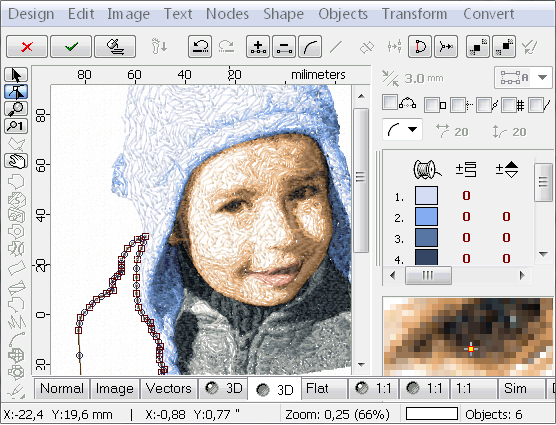Mastering the Embroidery Digitizing Refine: Your Ultimate Guide
Embroidery digitizing is a meticulous craft that requires accuracy and expertise to convert detailed styles into electronic layouts for machine needlework. As artisans start this journey to master the embroidery digitizing procedure, a detailed understanding of the fundamentals establishes the structure for quality. Beyond the basic expertise exists a realm of sophisticated software application, specialized tools, and nuanced strategies waiting to be explored. By diving into the nuances of digitizing, one can open a globe of creative opportunities and boost their embroidery jobs to brand-new heights.

Recognizing Needlework Digitizing Basics
Embroidery digitizing essentials develop the structure upon which complex designs are equated right into machine-readable styles for precise stitching. This first step in the needlework digitizing procedure is essential for making certain that the last embroidered item is a devoted depiction of the initial style. Recognizing needlework digitizing basics involves grasping key concepts such as stitch kinds, stitch direction, density, underlay, and pull compensation.
Stitch types play an important function in figuring out the aesthetic and textural end result of the stitched layout. By picking the proper stitch kind, whether it be satin, fill, or running stitch, digitizers can achieve the preferred result and boost the total quality of the embroidery. Additionally, stitch instructions affects the flow and dimension of the style, while density figures out the spacing and insurance coverage of the stitches.
Additionally, underlay stitching provides security to the style by securing the textile and stopping distortion during the needlework process. Pull payment is another essential factor to consider to combat the natural propensity of material to contract when stitched. Mastering these needlework digitizing fundamentals is essential for producing professional-quality embroidered items.
Selecting the Right Digitizing Software
Picking the suitable digitizing software program is a vital choice that considerably affects the performance and quality of the embroidery digitizing procedure. Digitizing for Embroidery. When picking the best digitizing software program, it is important to take into consideration factors such as the intricacy of layouts you plan to develop, the user-friendliness of the software program, the level of consumer support used, and the compatibility with your embroidery maker
There are various digitizing software application options offered in the market, ranging from fundamental programs for newbies to sophisticated software for expert digitizers. Some prominent choices consist of Wilcom other EmbroideryStudio, Hatch Embroidery Software, and PulseID. These software program bundles provide a vast array of tools and attributes to assist you develop elaborate designs effortlessly.
Before deciding, it is suggested to check out the different software program choices through cost-free trials or demos to determine which one ideal suits your demands. Additionally, checking out testimonials and looking for recommendations from experienced digitizers can offer useful understandings into the staminas and weak points of each software bundle (Digitizing for Embroidery). By meticulously evaluating your needs and comparing the functions of various digitizing software program, you can make an educated option that boosts your embroidery digitizing process
Digitizing Devices and Techniques

Optimizing Layout Settings for Needlework
Grasping the intricacies of layout settings is essential in accomplishing optimum cause the needlework digitizing procedure, structure upon the foundation laid by comprehending digitizing tools and strategies. When enhancing design settings for needlework, it is necessary to think about variables such as stitch type, density, padding, pull settlement, and enrollment. Sew kind choice affects the total look of the layout, with choices like satin, fill, and running stitches using different textures and results. Density describes the spacing and density of stitches, impacting the our website design's coverage and resilience. Proper padding sewing offers stability and protects against textile distortion, particularly for complex layouts or on stretchy materials. Draw payment adjusts for textile stretch throughout stitching, guaranteeing accurate layout duplication. Registration settings straighten different elements of the design properly, keeping general design honesty. By fine-tuning these layout settings, embroiderers can enhance the top quality and precision of their embroidered developments.

Troubleshooting Common Digitizing Issues
When experiencing common digitizing concerns during the needlework process, it is vital to comprehend the source and implement reliable services promptly. One typical problem is stitch thickness problems, where stitches may be also dense, creating the material to pucker, or as well sparse, leading to spaces in the design. Readjusting the stitch density setups in the digitizing software can aid solve this problem.
An additional frequent her latest blog obstacle is string breaks during the embroidery procedure. This can take place due to various reasons such as inaccurate stress setups, dull needles, or utilizing low-grade string. Guaranteeing appropriate upkeep of the needlework device, consisting of normal needle modifications and stress adjustments, can reduce the incident of string breaks.
Furthermore, style enrollment mistakes can result in misaligned elements within the needlework design. Inspecting the layout placement in the digitizing software application and making essential adjustments before sewing can help in avoiding this issue. By resolving these typical digitizing concerns immediately and properly, you can guarantee a smoother needlework process and high-quality ended up products.
Final Thought
Finally, grasping the embroidery digitizing procedure requires a solid understanding of the fundamentals, the right choice of software application, and understanding of devices and strategies. Optimizing style settings and troubleshooting common digitizing concerns are essential steps in ensuring high-grade needlework results. By complying with these steps diligently, one can accomplish precision and efficiency in the digitizing procedure.